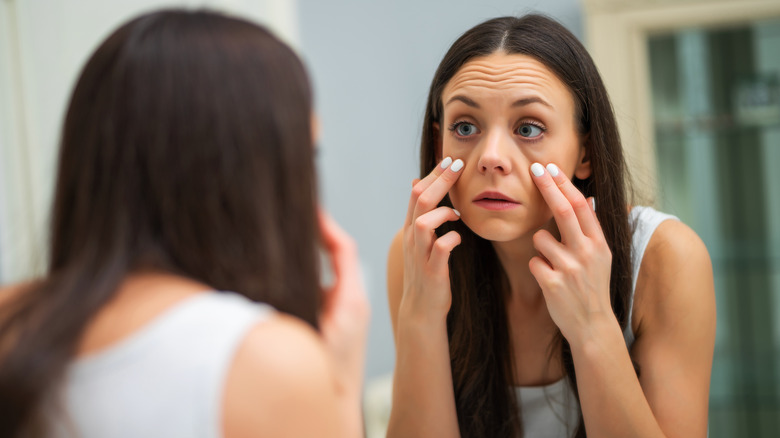
Conjunctivitis, blepharitis, allergies, and sleep deprivation are all common causes of red eyes. Too much screen time can turn your eyes red, too. WebMD reports that 50 to 90% of those who work at a computer have dry, red eyes, blurred vision, headaches, and other symptoms. If you’re skimping on sleep, you might wake up with bloodshot eyes. “Usually the eyes turn red because the blood vessels on the surface of the eye get dilated or inflamed,” Dr. Jessica Lee told Health.com. “The best way to calm them would be to get more sleep, and use artificial tears and cool compresses to ease the discomfort,” she added.
Eye redness usually subsides within hours or days, but this doesn’t mean you should ignore it. Treatment depends on what other symptoms you have. Ophthalmologist Catherine Hwang recommends seeking medical care if you experience eye pain, sensitivity to light, vision changes, or eyelid swelling in addition to red eyes (via the Mayo Clinic). Most conditions affecting the eye have similar symptoms, explains Dr. Hwang. For this reason, it’s important to contact your healthcare provider sooner rather than later. There’s nothing wrong with using OTC eye drops for a day or two, but you should seek help if your symptoms persist or worsen.
Eye redness may indicate an infection

The most common cause of red eye is conjunctivitis, according to Medscape. This condition can be caused by bacteria, viruses, or allergens and may affect one or both eyes. Its symptoms typically include a burning sensation, eye discharge, swollen eyelids, and sore, red eyes. You may also experience increased sensitivity to light, blurry vision, and a gritty sensation in the eye, says the American Academy of Ophthalmology (AAO).
Bacterial and viral conjunctivitis can easily spread from one person to another, so you should see a doctor as soon as possible. He may recommend antibiotic eye drops, artificial tears, ointments, or antihistamines, depending on the cause of your symptoms. This eye disease will eventually clear on its own, but you risk infecting other people. The AAO recommends seeking medical health if your symptoms last longer than one or two weeks. Meanwhile, avoid sharing your towels and makeup products. Refrain from touching your eyes and wash your hands as often as you can.
You may have a chronic eye condition

Blepharitis, or eyelid inflammation, has similar symptoms to conjunctivitis. It’s one of the most common causes of red eyes, itchy or swollen eyelids, crusted eyelashes, and sensitivity to light. Without proper treatment, it may lead to excessive tearing, eyelid scarring, chronic conjunctivitis, sties, or corneal injury. Its causes range from bacterial infection to eyelash lice and skin conditions like rosacea and seborrheic dermatitis, explains the Mayo Clinic. This condition is chronic, but it usually doesn’t affect eyesight.
Another potential cause of red eye is trachoma, a chronic infectious disease that may lead to blindness. Its symptoms tend to worsen over time and may include eye pain, light sensitivity, irritation, discharge, and eyelid swelling, according to the Mayo Clinic. The infection is highly contagious and can easily spread in crowded places.
Sometimes, eye redness is due to acute or chronic uveitis. This disease causes inflammation in the middle layer of the eye and may result in vision loss. Its symptoms resemble those of conjunctivitis and blepharitis, but you may also experience floaters in one or both eyes (per the National Eye Institute).
Allergies may cause red eyes, too

Your eyes could become red from allergies, irritation, or poor sleep. Exposure to common allergens, such as mold, pollen, or pet dander, may cause itching and burning along with eye redness. Cigarette smoke and other irritants have similar effects, according to the American College of Allergy, Asthma, and Immunology (ACAAI). Allergic reactions can range from mild to severe and may occur seasonally or year-round.
Eye allergies share many of the same symptoms as conjunctivitis and other diseases. In severe cases, they may affect your vision and lead to infection. Generally, artificial tears and decongestants only provide temporary relief, says the ACAAI. Your doctor may prescribe mast cell stabilizer eye drops, allergy shots, or more potent drugs that are not available over the counter.
Now that you know more about the most common causes of red eyes, take the steps needed to protect your vision. Small things, such as limiting screen time and getting regular eye exams, can make all the difference. As a rule of thumb, replace your makeup products every three to four months to prevent eye infections, suggests the University of Rochester. Health experts also advise against using glitter or metallic makeup, as it can irritate your eyes and cause infection.
Source: Read Full Article


